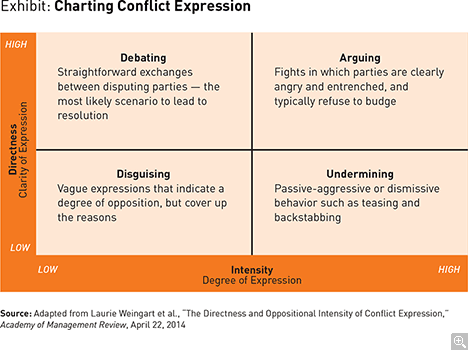Kristin Behfar on How We Fight at Work, and Why It Matters
The Darden School of Business professor describes a new framework for predicting conflict outcomes.
A version of this article appeared in the Summer 2015 issue of strategy+business.
You know the types. There’s the office yeller, intimidating others with vitriolic rant. There’s the passive-aggressive underminer, nodding assent but then dragging her feet. There’s the colleague who gets angry over a perceived slight, but then quickly shifts tone. Conflict in the workplace is pervasive and unavoidable. And it isn’t always a bad thing. A healthy debate can ensure that diverse perspectives are considered, clarify a dilemma, or light the fire a team needs to move from a stalemate to a creative solution. But when they turn ugly, conflicts are distressing and divisive. As they escalate, they strain relationships and put teams at risk.
Academic research has long focused on understanding conflict in hopes of enabling faster resolution—or better yet, avoiding conflict in the first place. It’s been a recurring theme for Kristin J. Behfar, an associate professor of business administration at the University of Virginia’s Darden School of Business who studies high-performance teamwork and effective leadership in organizations. Her most recent study, conducted with colleagues at several leading business schools, turns the traditional thinking about conflict on its head. Typically, substance—what we are fighting about—is thought to be the best predictor of a conflict’s outcome. But Behfar and her coauthors argue that we’re approaching it from the wrong angle. It’s how we fight, she explains in an interview with strategy+business, that determines what happens next. Behfar also offers some guidance on best practices for arguing (in U.S. workplaces, because cultural norms play a role in each country): Be direct, but not too intense. And when you validate your venting colleague’s feelings of hurt and anger, know that you may be doing a disservice.
S+B: How are you trying to change the conversation about conflict?
BEHFAR: Previous studies categorized conflict by type. For example, task conflict emerges when team members have differences of opinions about their work, and relationship conflict involves interpersonal animosity and ego clashes. Researchers would ask members of a team how frequently they engaged in each type of conflict, aggregate their responses, and use that as a team “score.” But this method yields mixed results—the empirical findings aren’t always consistent with what theory would predict. Why? This approach doesn’t consider that people can fight about the same thing in different ways, which will provoke different kinds of emotional responses.
This distinction is important, because we know that people respond to threats in fairly predictable ways. Of course, over time, coworkers get to know one another. They come to understand that the colleague who always seems to be undermining others isn’t malicious, she’s just a terrible communicator. But at many companies teams are fluid. Moreover, some teams will have a great success on one project, but can’t replicate the experience if you put them on a project that requires a different process.
My colleagues and I set out to understand how people’s conflict expression [how they express opposition verbally and nonverbally] creates or perpetuates these challenges. In other fields, including research on marriage, researchers have taken a similar approach. For example, the body of work by psychologist John Gottman and his colleagues includes years of observation and a codified scheme to describe different ways that couples fight—all of which enabled them to predict with great accuracy (94 percent in a 1999 study) which couples would split in the future.
S+B: When observing conflicts, what are you looking for? How do you measure expression?
BEHFAR: We developed a framework based on the idea that you can measure how people express conflict using two dimensions: their “directness” and their “oppositional intensity.” The first describes how directly, using words and body language, someone communicates information to the other party. A direct expression is literal and explicit. An indirect expression often involves a third party, like the proverbial game of telephone or office gossip, or occurs when a problem is hinted at but left to the listener to figure out.
To understand the other dimension, consider the difference between a trench and a foxhole. In a high-intensity scenario, the person has really dug in—he’s going to defend his trench or die trying. In a low-intensity situation, the person can still see the enemy’s position from his foxhole, and can adjust his position according to what the enemy does. At work, it’s more like the difference between an argument and a debate. In the former, which has high intensity, people cling fiercely to their positions. In the latter, someone is thinking about the other person’s point of view and incorporating it into her response. There’s still a line drawn in the sand, but it shifts with every exchange. Intensity can also be a matter of how subversive your intentions are. High intensity involves taking something from someone or intentionally blocking their interests. Low intensity is more about protecting one’s own interests.
“In a high-intensity conflict, the person has dug in—he’s going to defend his trench or die trying.”
S+B: So, if you can determine how direct and intense people are, you can predict how the conflict will play out?
BEHFAR: Yes, when you cross the two dimensions, you get telling patterns, or spirals [see exhibit]. We believe our categorizations of conflict expression apply across cultures. People everywhere use degrees of directness and intensity to communicate opposition. But for this study, we focused on U.S. organizations. This enabled us to assume that people had the same blueprint for how they perceive conflict expression. Even though many workplaces are multicultural, people working in the U.S. become familiar with its behavioral norms.
In conflicts where both directness and intensity are high, people might be shouting, storming out of the room, or rolling their eyes. People tend to react with anger and frustration. Little problem solving happens, because both parties pay more attention to defending their own arguments than they do to understanding the other person’s point of view. It’s worth noting that the outcome might be different if the conflict pairs someone with high status in the organization and someone with lower status. If the former individual is being very direct and intense, the lower-status recipient might withdraw or just comply—but the source of the conflict will continue to fester.
When conflicts are expressed with low directness and high intensity, they typically involve dismissive or passive-aggressive behavior. For example, actions such as teasing, backstabbing, or mobilizing a coalition send a message that there is a problem—the existence of a threat is clear—but the receiver has to figure out why the person is doing those things. Although there is no overt hostility or open fighting, people tend to respond by feeling anxiety and contempt, even humiliation or anger. These conflicts also tend to escalate, because people are focused on interpreting actions or protecting their interests rather than problem solving. Our anecdotal evidence and preliminary empirical evidence have shown that this type of conflict is the most common in U.S. organizations.
“Conflicts with low directness and high intensity typically involve passive-aggressive behavior.”
Also common are conflicts with low directness and low intensity, in which people avoid saying what they really mean and withhold critical information—often motivated by self-preservation. Here we often see less overtly threatening, more passive-aggressive behavior. For example, someone purposely misses a deadline because he doesn’t want a proposal to go through, and sends excuses to his colleagues. This leaves it up to others to consider whether his error was intentional. People often feel hurt or irritated, even guilty or confused, because they’re not really sure what the problem is, and whether they caused it. Escalation here might be less obvious than with the previous combinations, but the uncertainty involved typically results in negative outcomes.
When directness is high and intensity is low, people are not entrenched, and they’re not being subversive. But they are communicating unambiguously what they mean to the other party. The emotions associated with this type of conflict expression tend to be mixed. Someone might think, I’m frustrated that this person is opposing me, but I’m also excited because I see a potential for learning something. Because people typically respond calmly and rationally, this scenario is the most likely of the four to lead to resolution.
S+B: What role do cultural differences play?
BEHFAR: Our framework outlines how to categorize expressions. But culture is an important context for predicting how those expressions will be interpreted. It would be incorrect to conclude based on our work that direct expression is always better—that everywhere in the world unambiguous words and action are the best way to get the other party to understand your position. This is true in the U.S., where people appreciate directness, and where most people are left confused and frustrated by indirect confrontation. But in some cultures, for example, in Japan, people frown on direct confrontation and perceive it as unnecessary or uncouth—perhaps even insulting. And research has demonstrated that for those culturally conditioned to pick up on indirect communication, no meaning is lost in conflicts with low directness.
I said earlier that people respond to threats in predictable ways. But we all interpret the degree of a threat differently, depending on our expectations. And these expectations aren’t just based on culture. Other factors, such as gender and race—also influence perception. For example, women are more likely than men to become infuriated when confronted with the same type of conflict expression repeatedly, with no progress made toward a resolution. We are hoping to expand our study to see how these differences affect outcomes.
S+B: You’ve also done research on venting. Can our reaction to people’s everyday complaints help encourage conflict resolution?
BEHFAR: Venting is a common way of making sense of frustrating events—like conflict—in the workplace, because it’s not a formal or even an informal type of grievance. After a high-intensity conflict, when you are feeling anxious or insulted, turning to a trusted friend or coworker to unload about what is bothering you is a natural way to cope.
We were interested in understanding whether listeners could help venters better understand how to prevent the type of negative escalation I discussed earlier. We found that when the listener was able to give the venter new insight into or perspective on her problem or feelings, the venter was better able to work through the issue with the other party. But the listener having knowledge of the problem (and thus the ability to give specific insight) was not necessary. Just helping people to reframe the annoyance into a bigger picture helped them get back to work much faster.
What was ineffective? Unfortunately, it was what many of us do when placed in the listener role: sympathizing and reaffirming the venter’s frustration. If we can control our reaction, we can encourage better outcomes. This is one of the most common—and most important—themes in all of my research. And it’s true across cultures, in any context. If you understand the patterns of how people respond to different deliveries, you can ensure that you don’t respond in kind, and can engage in a more proactive process of resolving conflict. This brings to mind the work of psychiatrist William Glasser, who said that you can’t control other people, you can only control what you give them to react to. I think a hallmark of executive talent is understanding how to recognize the problem, rather than just reacting to the noise. ![]()
Reprint No. 00314






